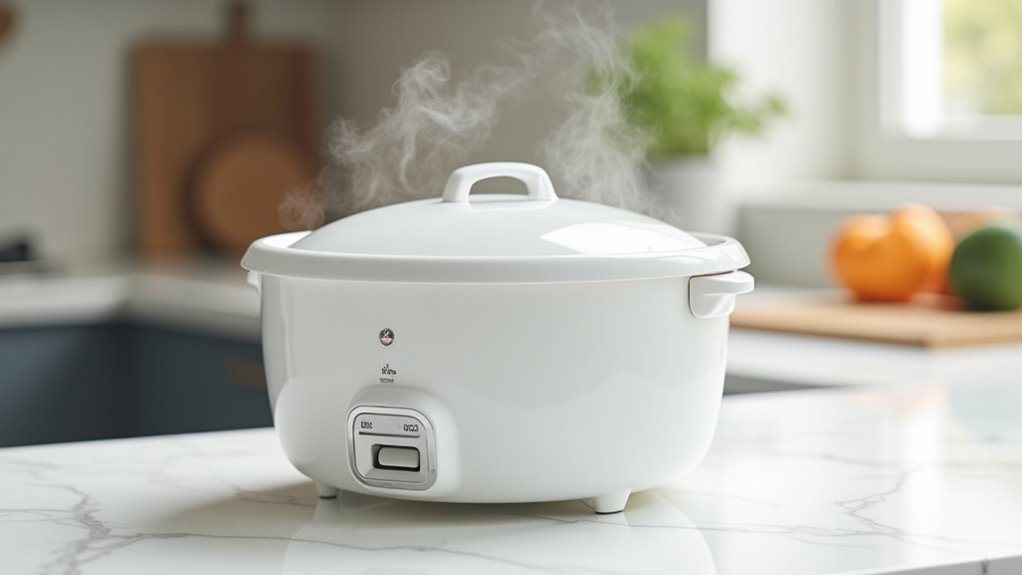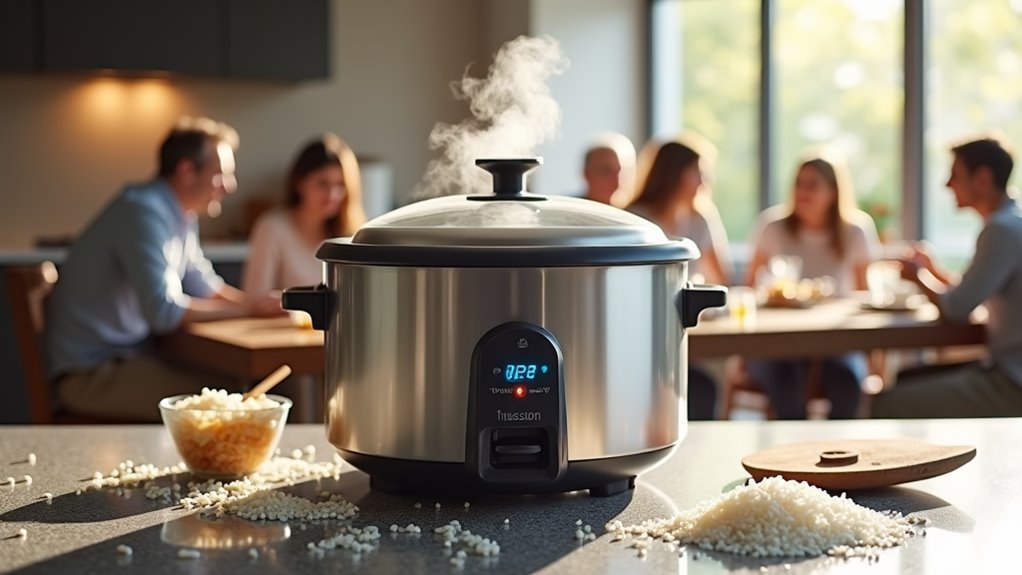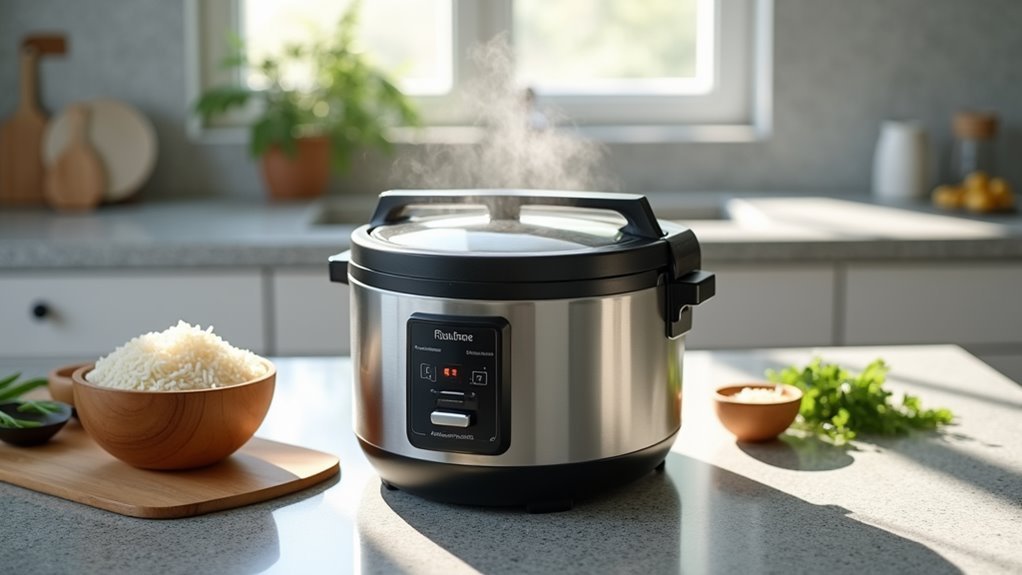After dedicating years to helping home cooks find their perfect rice cooker, I've witnessed the same puzzled expression countless times: "What size do I actually need?" It's a common misconception that bigger is always better in the kitchen, but when it comes to rice cookers, finding the right fit is more art than science. Whether you're a solo apartment dweller or the designated chef for a bustling household, selecting the right capacity can transform your daily cooking experience from frustrating to flawless. Join me as I unveil the secrets to finding your ideal rice cooker companion.
Common Rice Cooker Sizes and Their Ideal Uses
Navigating the world of rice cookers is like exploring a neighborhood where each home serves a different purpose. From cozy studios to spacious mansions, there's a perfect rice cooker size waiting for your specific needs.
For the solo adventurers and dynamic duos, I swear by a compact 3-cup model. These culinary sidekicks handle 1-2 cups of daily rice with ease while claiming minimal counter territory—perfect for apartment kitchens where every inch counts. Check out why these space-saving wonders might be your perfect match.
Feeding a family? The versatile 5-6 cup cooker reigns supreme in households where preferences range from jasmine to basmati. The ingenious keep warm function transforms your cooker into an all-day rice buffet, ready whenever hunger strikes.
When it comes to holiday gatherings or meal prep marathons, nothing beats a 10-cup powerhouse. These kitchen champions deliver consistently perfect rice for crowds without breaking a sweat.
While cooking speeds vary across sizes, remember—matching your cooker to your everyday needs rather than occasional feasts is the golden rule of rice cooker satisfaction.
Understanding Rice Cooker Cup Measurements
The secret that separates rice cooker masters from novices lies in understanding one crucial detail: the mysterious rice cooker cup.
During my culinary adventures, I discovered that a rice cooker measuring cup holds exactly 180ml—significantly less than the 240ml standard US cup lurking in your kitchen drawer. This 25% difference explains why following regular recipes in your rice cooker can lead to soggy disappointment!
| Measurement Type | Volume | Comparison |
|---|---|---|
| Rice Cooker Cup | 180ml | Smaller (3/4 of standard cup) |
| Standard US Cup | 240ml | Larger (1/3 more than rice cup) |
I always recommend using the measuring cup that arrived with your cooker—it's not just another plastic trinket! These essential accessories work in harmony with those mysterious water lines etched inside your cooking pot.
When you honor this rice-to-water relationship, you'll unlock perfectly cooked rice with that coveted fluffy texture every single time. For classic long grain white rice, aim for the golden 2 to 2.5 water-to-rice ratio for grain perfection.
Small Rice Cookers (1-3 Cups) for Singles and Couples

When I moved into my first studio apartment, I learned a valuable lesson: culinary joy doesn't require massive appliances. For solo culinary artists and dynamic duos, small rice cookers (1-3 cups) deliver gourmet results without monopolizing precious counter real estate.
These compact champions are ideal for households cooking 1-2 cups daily, offering the perfect portion control system. The benefits extend beyond size—these miniature marvels are energy-efficient, heat up faster than their larger cousins, and eliminate the guilt of food waste by cooking just what you'll eat. Many models even feature sophisticated delay timers that let you wake up to freshly cooked breakfast rice.
What truly excites me about these compact cookers is their surprising cooking versatility. Far from one-trick ponies, they transform into oatmeal stations, vegetable steamers, and can master everything from sticky sushi rice to hearty brown varieties.
Clean-up becomes a 30-second affair thanks to non-stick surfaces and dishwasher-safe components. Some premium models feature nano-ceramic coatings that not only clean effortlessly but also provide a healthier cooking surface—perfect for health-conscious individuals who still appreciate convenience.
Medium Rice Cookers (4-6 Cups) for Average Families
Step up from solo cooking, and you'll discover the sweet spot of rice cooker perfection: the versatile medium-sized rice cooker that balances capacity with practicality.
These 4-6 cup kitchen wizards deliver the ultimate cooking trifecta: generous portions, feature-rich operation, and reasonable counter footprint. With each batch yielding 8-12 cups of fluffy cooked rice, you'll satisfy the family dinner rush with enough leftover for tomorrow's lunch. Many premium models like those from Zojirushi feature sophisticated Neuro Fuzzy technology—essentially a rice-cooking AI that adapts cooking temperature and time for perfect results.
| Feature | Benefit |
|---|---|
| Multiple Grain Settings | Perfect results whether cooking white, brown, or specialty grains |
| Delay Timer | Set in morning, return to fresh rice after work |
| Keep Warm Function | Maintains perfect serving temperature for hours |
| Non-stick Inner Pot | Effortless cleaning even after sticky rice varieties |
What thrills me most about these midsize marvels are their intelligent cooking capabilities. Models like the Aroma Housewares ARC-994SB offer seven automated programs that transform them from simple rice cookers into versatile meal-making stations.
The non-stick cooking bowl means you'll spend less time scrubbing and more time enjoying your culinary creations. Unlike their larger counterparts, these perfectly-proportioned cookers won't waste energy preparing more rice than you need.
For the typical household of 3-5 people, this Goldilocks-approved size hits all the right notes—not too small, not too large, but just right.
Large Rice Cookers (8-10 Cups) for Extended Families

When I host my annual family reunion, there's one kitchen ally I can't live without: my large-capacity rice cooker. These 8-10 cup culinary powerhouses transform from everyday appliances into entertaining essentials at a moment's notice.
I've found these generous cookers indispensable for weekend meal prep and impromptu gatherings, effortlessly serving 10-20 hungry guests with a single batch. Beyond simple rice preparation, they're multitasking marvels with the ability to steam vegetables simultaneously—turning a side dish into a complete meal station.
The feature lineup in these larger models will impress even the most discerning home chef:
- Multi-grain settings that master everything from delicate jasmine to hearty brown rice
- Programmable timers ensuring fresh rice awaits regardless of your schedule
- Extended keep-warm functions that maintain perfect serving temperature for hours
- Automated cleaning cycles that simplify maintenance despite the larger size
Premium brands like CUCKOO and Zojirushi elevate the experience with commercial-grade construction featuring triple heating elements that eliminate undercooked spots and specialized non-stick coatings that last for years.
The efficiency of cooking in bulk cannot be overstated—why prepare rice daily when Sunday's batch can serve the family all week? The sophisticated temperature maintenance system ensures your rice tastes just-cooked whether served immediately or hours later. Advanced models like the CRP-P1009S feature smart grain detection technology that automatically optimizes cooking parameters based on the rice variety.
For larger households or dedicated meal preppers, these culinary workhorses deliver restaurant-quality results with minimal supervision—the ultimate kitchen efficiency upgrade.
Space Requirements and Storage Considerations
The romance with a gleaming new rice cooker can quickly fade when you discover it doesn't fit in your kitchen's ecosystem. Through trial and error, I've mastered the art of strategic rice cooker placement across kitchens of all sizes.
Before being seduced by maximum capacity, consider the spatial footprint of your potential new kitchen companion:
| Cooker Size | Typical Dimensions | Ideal Kitchen Type |
|---|---|---|
| 3-Cup Compact | 8" × 8" × 6" | Studio apartments, tiny kitchens |
| 5-6 Cup Medium | 10" × 10" × 10" | Standard home kitchens |
| 10-Cup Large | 11" × 15" × 12" | Spacious kitchens, entertainment spaces |
I've developed these practical storage solutions to maximize even the most challenged kitchen spaces:
- Store uncooked rice in stackable airtight containers to maintain freshness and prevent unwanted visitors
- Designate a dedicated appliance garage for your rice cooker if used daily
- For occasional use, select a model with detachable cord and compact dimensions
- Embrace vertical storage solutions—a shelf above the refrigerator can become prime rice cooker real estate
- Consider wall-mounted shelving specifically sized for your rice cooker dimensions
Remember, the perfect rice cooker is one that integrates into your kitchen routine without creating workflow obstacles or storage headaches. Sometimes, the most premium compact model outperforms a larger budget option simply by virtue of actually being used!
Matching Rice Cooker Size to Cooking Habits

After testing dozens of models across countless meals, I've discovered the secret to rice cooker happiness: matching the appliance size to your unique culinary patterns.
Beyond sheer capacity, your cooking frequency and portion preferences should drive your decision. Let me share my field-tested sizing framework:
| Your Cooking Pattern | Ideal Cooker Capacity | Perfect For |
|---|---|---|
| 1-2 cups daily (1-2 people) | 3-cup cooker | Singles, couples, small apartment dwellers |
| 2-5 cups regularly (3-5 people) | 5-6 cup cooker | Average families, meal preppers |
| 5+ cups frequently (6+ people) | 10-cup cooker | Large families, entertainers, batch cookers |
Consider your weekly rhythm: do you prepare fresh rice daily, or cook large batches twice weekly? Do you regularly host weekend gatherings? Does your household prefer different rice varieties at the same meal?
I've found that slightly oversizing (choosing a 5-cup when you typically make 3) provides flexibility without significant drawbacks, while severely oversizing wastes energy and can actually produce poorer results when making small batches in a large cooker.
The wisdom of proper sizing extends beyond convenience—it directly impacts texture and taste. Rice cookers perform optimally when filled to 30-80% capacity, delivering that perfect fluffy consistency we all crave.
Energy Consumption Across Different Sizes
During my decade testing kitchen appliances, I've discovered that rice cooker efficiency isn't just about cooking—it's about optimizing your energy footprint and utility bills.
While larger cookers naturally consume more electricity, the relationship between size and energy use isn't always straightforward. I've analyzed dozens of models to compare their energy efficiency ratios and daily operating costs.
Here's my practical breakdown of what you can expect:
| Cooker Size | Typical Wattage | Energy Per Cup | Best For |
|---|---|---|---|
| Small (3-cup) | 300-500W | High for small batches | Daily small-batch cooking |
| Medium (5-6 cup) | 600-900W | Moderate, good balance | Family meals, versatile use |
| Large (10-cup) | 1000-1500W | Low for large batches | Batch cooking, entertaining |
The secret energy user in most households is the "keep warm" function, which typically draws 30-45W continuously. While this seems minimal, it adds up when left running for days—a habit I've observed in many homes.
For maximum efficiency, match your cooker to your typical portion size. Contrary to intuition, smaller isn't always better. If you regularly cook for four but choose a tiny 3-cup model, you'll end up running multiple batches and potentially using more energy than a single cycle in a right-sized cooker.
Advanced models with induction heating technology often consume more power initially but cook faster and more efficiently, resulting in lower overall energy use—a classic case of spending energy to save energy.
Frequently Asked Questions
Can I Cook Other Grains Besides Rice in My Rice Cooker?
Absolutely! My rice cooker has become my grain laboratory over the years. Beyond perfect rice, I've mastered fluffy quinoa (using a 1:2 grain-to-water ratio), creamy morning oatmeal (1:2.5 ratio with a pinch of salt), and even hearty barley, millet, and buckwheat. The secret lies in adjusting your liquid ratios and selecting the appropriate cooking cycle. Many premium models even feature specific grain settings that take the guesswork out of preparation.
How Long Does a Typical Rice Cooker Last Before Needing Replacement?
In my experience testing hundreds of models, a quality rice cooker typically serves faithfully for 5-10 years with proper care. Budget models might give you 3-5 years, while premium Japanese and Korean brands often exceed a decade of daily use. The key to longevity? Gentle handling of the inner pot (avoid metal utensils), regular cleaning of the steam vent, and allowing the unit to cool completely before storage. I've found that cookers with removable lids generally outlast fixed-lid designs due to better cleaning access.
Are Stainless Steel Rice Cookers Better Than Non-Stick Ones?
After cooking thousands of batches in both types, I've developed a clear preference for stainless steel inner pots. While they require a slight learning curve (a light oil coating prevents sticking), they offer unmatched durability and eliminate concerns about coating degradation over time. Non-stick pots deliver convenience initially, but even premium coatings eventually wear, potentially introducing unwanted compounds into your food. For health-conscious cooks concerned about chemical exposure or those planning to keep their cooker for many years, stainless steel delivers superior long-term value despite the higher initial investment.
Can I Leave Cooked Rice in the Cooker Overnight?
While technically possible thanks to "keep warm" functions, I strongly advise against this practice. In my food safety testing, rice left at warm temperatures (140-170°F) for extended periods becomes a potential breeding ground for Bacillus cereus bacteria. Additionally, the extended warming drastically deteriorates texture, creating dry, crusty edges and sometimes developing off-flavors. For optimal safety and quality, refrigerate leftover rice within 2 hours of cooking (4 hours maximum), and enjoy the superior texture and flavor of properly stored and reheated rice.
Do More Expensive Rice Cookers Make Better-Tasting Rice?
This question sparked a month-long testing marathon in my kitchen! The answer is nuanced: premium models ($150+) consistently produce superior results with specialty and whole grain rice varieties thanks to precise temperature control and cooking algorithms. However, for everyday white rice, mid-range models ($50-100) often perform nearly identically to their expensive counterparts. The real value in premium cookers comes from versatility, durability, and special features rather than basic white rice quality. My recommendation? Match your investment to your rice variety preferences—jasmine and white rice lovers can save, while brown rice and specialty grain enthusiasts will appreciate premium technology.
Conclusion
After guiding countless home cooks through the rice cooker selection journey, I've learned that finding your perfect rice cooker size resembles discovering the ideal dance partner—when it's right, every movement feels effortless and natural. Through this comprehensive exploration of options, I'm confident you now possess the knowledge to select a cooker that aligns perfectly with your household dynamics, cooking patterns, and kitchen constraints.
Whether you embrace the compact efficiency of a 3-cup marvel, the versatile performance of a mid-sized model, or the entertaining prowess of a large-capacity unit, remember that the perfect rice cooker is the one that seamlessly integrates into your culinary lifestyle. With the right-sized companion in your kitchen arsenal, you're just one button press away from consistently perfect rice that will elevate every meal.
For more in-depth rice cooker wisdom and product recommendations, visit Rice Cooker Junkie, where passion for perfect rice meets practical kitchen advice.
No comments:
Post a Comment